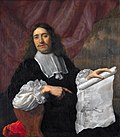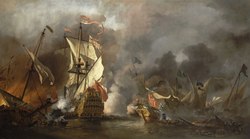
Original file (7,200 × 3,998 pixels, file size: 82.36 MB, MIME type: image/tiff)
| This is a file from the Wikimedia Commons. Information from its description page there is shown below. Commons is a freely licensed media file repository. You can help. |
Summary
| Willem van de Velde the Younger: An English Ship in Action with Barbary Vessels
|
|||||||||||||||||||||||||||
|---|---|---|---|---|---|---|---|---|---|---|---|---|---|---|---|---|---|---|---|---|---|---|---|---|---|---|---|
| Artist |
|
||||||||||||||||||||||||||
| Title |
An English Ship in Action with Barbary Vessels |
||||||||||||||||||||||||||
| Object type |
painting |
||||||||||||||||||||||||||
| Genre |
marine art |
||||||||||||||||||||||||||
| Description |
English: An English ship, on the left, battles with a ‘Barbary’ ship and two galleys. Smoke fills the sky and the gunfire, which reflects in the sea, illuminates the sails of the ships and their flags. In the left foreground is the forepart of the Barbary ship which is much damaged and listing to port. She appears to be on fire amidships. There is a boat on her port bow which is picking up survivors. Beyond her are the masts of another ship which is blowing up. On the right is a galley sinking and, beyond her, another galley viewed from the starboard quarter. The masts and sails of three other galleys appear above the smoke. In the centre background, above the smoke, is a Barbary ship with a flag at the main. She has listed to starboard. On the left a large English two-decker, viewed from the port quarter, is heavily engaged with Barbary ships to port and starboard. The two-decker flies a Union flag at the mizzen and a red pendant at the main which may be a signal for help. The Barbary corsairs operated from the main coastal cities of northern Africa. Naval expeditions against these centres were carried out by various European nations from the seventeenth century.
This is one of van de Velde’s most dramatic battle scenes and is painted in an unusually flamboyant manner. It echoes earlier paintings by Dutch artists such as 'Spanish Men-of-War Engaging Barbary Corsairs' (BHC0799) by Cornelis Hendricksz Vroom which shows combat against vessels of the corsair states of northern Africa. This painting is believed to depict an action which took place after the burning of the ships in Tripoli on the night of 14/15 January 1676 and before Sir John Narborough's departure for Malta in early February. Therefore this painting could have been commissioned by Narborough and he may have supplied van de Velde with the details for the scene. However while many of van de Velde’s paintings depict clearly identifiable events, such as the battles of the Second and Third Anglo-Dutch Wars, a large proportion of his paintings of English ships fighting Barbary opponents have defied historical identification. This suggests that, similar to his Dutch predecessors, van de Velde never intended them as literal depictions. Barbary subjects, with their strong suggestion of the exotic and oriental, gave van de Velde the opportunity to show off his skills as a painter. Such subjects freed him from the constraints which accompanied the more usual battle scenes for example those painted for his English patrons. This painting has a dramatic composition and colouring, a strong sense of rhythmic movement across the picture surface as well as a freedom of handling. This is in contrast with the dry and factual scenes painted for the Duke of York. The composition relates to that of the much smaller painting over the fireplace in the Duke of Lauderdale’s closet at Ham House. This would clearly have been conceived as having a decorative function rather than a commemorative one and a similar case may be made for this painting. A rapidly made drawing which relates to it, possibly made in preparation, is in the National Gallery of Ireland, Dublin. Among the Museum’s collection there are at least two drawings by van de Velde which show fights in boats with Barbary corsairs. They are presumably studies for paintings of this kind. Van de Velde was the younger son of Willem van de Velde the Elder. Born in Leiden, he studied under Simon de Vlieger in Weesp and, in 1652, moved back to Amsterdam. He worked in his father's studio and developed the skill of carefully drawing ships in tranquil settings. He changed his subject matter, however, when he came with his father to England in 1672-73. Increasingly he concentrated on royal yachts, men-of-war and storm scenes. From this time painting sea battles for Charles II and his brother (and Lord High Admiral) James, Duke of York, as well as other patrons became a priority. Unlike his father's works, however, they were not usually eyewitness accounts. After his father's death in 1693 his continuing role as an official marine painter obliged him to be present more frequently at significant maritime events. |
||||||||||||||||||||||||||
| Date |
1678 |
||||||||||||||||||||||||||
| Medium |
oil on canvas |
||||||||||||||||||||||||||
| Dimensions | Painting: 1092 mm x 1981 mm; frame dimensions: 1322 x 2184 x 98 mm | ||||||||||||||||||||||||||
| Collection |
institution QS:P195,Q7374509
|
||||||||||||||||||||||||||
| Current location | |||||||||||||||||||||||||||
| Accession number |
BHC0893 (Royal Museums Greenwich) |
||||||||||||||||||||||||||
| Object history |
until 1971 date QS:P,+1971-00-00T00:00:00Z/7,P582,+1971-00-00T00:00:00Z/9 (number 1941-101): acquired by from Lady Alington (acc. to Caird cards state) |
||||||||||||||||||||||||||
| Inscriptions |
Signature: W.V.Velde
|
||||||||||||||||||||||||||
| Notes | This object was sighted as being on display during the Collections Inventory Project (2001-2005). It will need to be checked for object numbers and its condition activity updated | ||||||||||||||||||||||||||
| References | |||||||||||||||||||||||||||
| Source/Photographer | http://collections.rmg.co.uk/collections/objects/12385 | ||||||||||||||||||||||||||
| Permission (Reusing this file) |
The original artefact or artwork has been assessed as public domain by age, and faithful reproductions of the two dimensional work are also public domain. No permission is required for reuse for any purpose. The text of this image record has been derived from the Royal Museums Greenwich catalogue and image metadata. Individual data and facts such as date, author and title are not copyrightable, but reuse of longer descriptive text from the catalogue may not be considered fair use. Reuse of the text must be attributed to the "National Maritime Museum, Greenwich, London" and a Creative Commons CC-BY-NC-SA-3.0 license may apply if not rewritten. Refer to Royal Museums Greenwich copyright. |
||||||||||||||||||||||||||
| Identifier InfoField | Acquisition Number: 1939-1571 Robinson Cat No: 319 id number: BHC0893 |
||||||||||||||||||||||||||
| Collection InfoField | Oil paintings | ||||||||||||||||||||||||||
Licensing
|
This is a faithful photographic reproduction of a two-dimensional, public domain work of art. The work of art itself is in the public domain for the following reason:
The official position taken by the Wikimedia Foundation is that "faithful reproductions of two-dimensional public domain works of art are public domain".
This photographic reproduction is therefore also considered to be in the public domain in the United States. In other jurisdictions, re-use of this content may be restricted; see Reuse of PD-Art photographs for details. | |||||
Captions
Items portrayed in this file
depicts
image/tiff
be603d1a3b3122ef0102c379864d506a5a6cb29a
86,356,940 byte
3,998 pixel
7,200 pixel
File history
Click on a date/time to view the file as it appeared at that time.
| Date/Time | Thumbnail | Dimensions | User | Comment | |
|---|---|---|---|---|---|
| current | 21:26, 22 September 2017 |  | 7,200 × 3,998 (82.36 MB) | Fæ | Royal Museums Greenwich Oil paintings (1678), http://collections.rmg.co.uk/collections/objects/12385 #1288 |
File usage
Global file usage
The following other wikis use this file:
- Usage on fr.wikipedia.org
- Usage on www.wikidata.org
Metadata
This file contains additional information, probably added from the digital camera or scanner used to create or digitize it.
If the file has been modified from its original state, some details may not fully reflect the modified file.
| Width | 7,200 px |
|---|---|
| Height | 3,998 px |
| Bits per component |
|
| Compression scheme | Uncompressed |
| Pixel composition | RGB |
| Image data location | 140 |
| Number of components | 3 |
| Number of rows per strip | 3,998 |
| Bytes per compressed strip | 86,356,800 |
| Data arrangement | chunky format |


